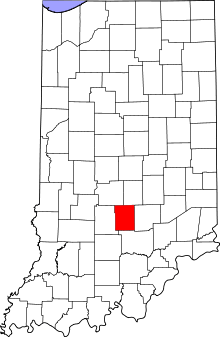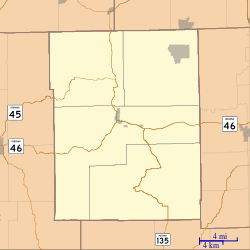Story, Indiana
| Story | |
|---|---|
| Unincorporated community | |
 Brown County's location in Indiana | |
 Story Location in Brown County | |
| Coordinates: 39°05′56″N 86°12′50″W / 39.09889°N 86.21389°WCoordinates: 39°05′56″N 86°12′50″W / 39.09889°N 86.21389°W | |
| Country | United States |
| State | Indiana |
| County | Brown |
| Township | Van Buren |
| Elevation[1] | 577 ft (176 m) |
| ZIP code | 47448 |
| FIPS code | 18-73628[2] |
| GNIS feature ID | 451514 |
Story is an unincorporated community in Van Buren Township, Brown County, Indiana.
History
This area of the state now known as Indiana was opened to European settlement on September 30, 1809, upon the consummation of a treaty between Governor William Henry Harrison and the Miami Indians. The so-called “Ten O’clock Treaty” opened three million acres (12,000 km²) to settlement, the boundary being a line running from Raccoon Creek on the Wabash River near Montezuma to Seymour, marked by a shadow cast at 10:00 a.m. each September 30. That line passed through the heart of what would become the town of Story. Today, that line is denoted by the Story Monument in the center of Story’s village green.
Though historians disagree on the exact origins of the village of Story itself, one theory says it was founded in 1851, with the grant of a land patent from President Millard Fillmore to Dr. George Story. This original land patent is on display at the Story Inn. Dr. Story was a medical doctor who hailed from a clan of timber harvesters in southern Ohio. He and his progeny built many of the structures which distinguish this town today from the then-ample supply of domestic hardwoods. His home and medical office nearby both managed to survive the forces of entropy.
Story soon became what was said to the largest settlement in the area. In its heyday (1880–1929) the village supported two general stores, a nondenominational church, a one-room schoolhouse, a grain mill, a sawmill, a slaughterhouse, a blacksmith’s forge and a post office.
According to oral history, Story never recovered from the Great Depression (1929–1933), as families abandoned their hilly, marginal farms in search of work elsewhere, a departure plucked from The Grapes of Wrath. Brown County lost half of its population between 1930 and 1940. This exodus of people paved the way for the creation of the Brown County State Park and the Hoosier National Forest, as farmland escheated to the government for non-payment of taxes. For that reason, Brown County is 80% forested today (second-growth, but still impressively mature).
The economic hardship also fostered a cottage industry producing bathtub gin of rather dubious quality, an activity which apparently kept the grain mill at Story occupied well into the 1930s. Sheriff Clarence Moore made local headlines in 1932 when he captured a still at Story; today his daughter discloses that several gallons disappeared from the evidence room.
The United States Army Corps of Engineers flooded the area in 1960, creating Lake Monroe, Indiana’s second largest lake, but consequently inundating the little town of Elkinsville and cutting Story’s access to Bloomington via Elkinsville Road. Elkinsville Road is Story’s main street, which now dead-ends four miles (6 km) to the west at a fallen iron bridge. Isolated, Story’s economic fate was sealed. Story’s General Store limped along until the Nixon Administration, dispensing Moon Pies, Nehi sodas and leaded gasoline. The Gold and Red Crown Standard gas pumps still stand today and are said to be on top of a huge reserve of gasoline waiting for someone with access to a pump.
This paucity of capital was, in retrospect, a blessing. No new construction followed the Great Depression, and fortuitously, no one attempted to “modernize” the venerable but aging structures at Story when the rest of the nation embarked upon a campaign to eliminate unsightly wooden floors, stamped tin metal ceilings and globe lighting and replace them with shiny asbestos floor tiles and dropped fiberboard ceilings sporting snazzy new recessed neon bulbs.
Benjamin (one name) and his wife Cynthia Schultz purchased the General Store building in 1978. Benjamin, an architect and builder with restaurant experience, and Cynthia, a former restaurant owner, jointly pursued their vision of creating a bed and breakfast now known as The Story Inn. They gave birth to their children in what is now known as the Morrison-Kelly Room upstairs. The business prospered, and over the following decade and a half, the couple acquired the nearly 23-acre (93,000 m2) tract that comprises the town.
The entire town of Story, Indiana, is now a country inn/bed & breakfast, offering fine dining, catering, and lodging. The second floor of the Old General Store (briefly a Studebaker buggy factory in the 1920s) has been renovated into four quaint bed & breakfast accommodations notable for their year-round occupant, the “Blue Lady.” The Blue Lady is a mirthful albeit innocuous apparition with flowing white robes, whose cheeky behavior has been observed by Story Inn employees and recorded in guest books since the 1970s. (Current management notes that the frequency of her appearances increased markedly after 2001, coinciding with the arrival of a complimentary bottle of privately labeled wine in each room.) The Treaty House, Doc Story’s homestead, the Alra Wheeler homestead, the Carriage House, the Old Mill, and other historic buildings around town have each been tastefully and authentically renovated into guest cottages, many with kitchenettes and hot tubs.
Story’s Old General Store, replete with its creaky wooden floors, pot-bellied stove and long-retired Standard Oil Crown gas pumps out front, is now a celebrated gourmet restaurant known as the “Story Inn.” The restaurant is open year-round, serving for breakfast, lunch and dinner. Dinners are by reservation only.
Nature has reclaimed most of Brown County, and today the area surrounding Story is wild and natural. Story sits at the edge of Salt Creek, a labyrinthine 100-mile (160 km) system of quiet, slow-moving tributaries which now form the backwaters of Lake Monroe. This moist bottomland, now under the protection of the Indiana Department of Natural Resources, is a spectacular spawning ground for fish and fowl alike, a place of serenity and raw beauty found nowhere else in Indiana.
References
- ↑ "US Board on Geographic Names". United States Geological Survey. 2007-10-25. Retrieved 2008-01-31.
- ↑ "American FactFinder". United States Census Bureau. Retrieved 2008-01-31.
- Inman, N. Carol (1991). The Origins of 1001 Towns In Indiana. Indiana State Historical Association.